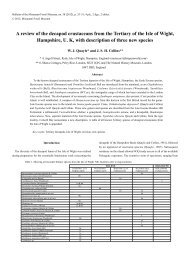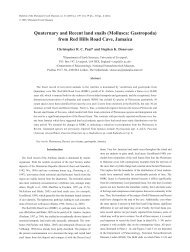Raninidae infested by parasitic Isopoda (Epicaridea)
Raninidae infested by parasitic Isopoda (Epicaridea)
Raninidae infested by parasitic Isopoda (Epicaridea)
Create successful ePaper yourself
Turn your PDF publications into a flip-book with our unique Google optimized e-Paper software.
Macrura, Anomura or Brachyura.<br />
___________________________<br />
<strong>Raninidae</strong> <strong>infested</strong> <strong>by</strong> <strong>parasitic</strong> <strong>Isopoda</strong> (<strong>Epicaridea</strong>) 35<br />
Sincerely yours,<br />
[signed] John C. Markham.”<br />
Also, the numerous callianassid specimens present in the West<br />
Greenland collection still await attention.<br />
Wienberg mentioned the larval parasite infesting the decapod,<br />
but prior to that, on hatching, the larva undergoes initial<br />
development in a copepod host before seeking a decapod as<br />
secondary host, in which it waits until the next moulting stage of<br />
the host before completing final development which causes the<br />
characteristic swelling. Thereafter, the female parasite moults in<br />
synchrony with its host (Overstreet, 1983). The male is diminutive<br />
and associated with the genital region of the female (Sars,<br />
1899). The earliest known occurrence of a bopyric swelling for<br />
brachyurans is from the Oxfordian and for macrurans it is the<br />
Toarcian. Although not recognised in the fossil record until the<br />
Miocene (Schram, 1979, pp. 240, 242), <strong>by</strong> inference, and assuming<br />
an uninterupted life-style, it means that copepods must have been<br />
coeval with the decapods! Concluding his discussion of <strong>infested</strong><br />
Jurassic species, Housˇa (1963) stated that the parasites stopped<br />
growth and moulting of their hosts, and that large swellings in adult<br />
crabs was the result of late infestation of the crab. However, this<br />
opinion is contrary to the presence of obviously <strong>infested</strong> moults of<br />
varying growth-stages which, in multi-evidenced species, equals –<br />
or outnumbers – known corpses. It is evident that Weinberg dwelt<br />
long upon ratios and probabilities – the value of which is probably<br />
best demonstrated in large faunas such as those mentioned <strong>by</strong><br />
him, namely the Jurassic prosoponids, and Greenland raninids and<br />
mecochirids. But a considerable number of species potentially<br />
subject to parasitism are known <strong>by</strong> one or very few specimens,<br />
and it would seen logical to expect that as these species become<br />
better known, the probability of <strong>infested</strong> specimens increases.<br />
Likewise, the chance occurrence of an <strong>infested</strong> individual among<br />
a mere handful of specimens of a species is no indication of ratio<br />
regularity.<br />
Commenting on the value of percentages among fossil forms,<br />
Conway Morris (1981), quoting from Bachmayer (1948), Housˇa<br />
(1963), Förster (1969) (chronologically overlooked <strong>by</strong> Wienberg),<br />
and Radwanski (1972), added the important fact that percentages<br />
of samples are open to, ‘preferential removal or destruction of<br />
distorted carapaces, collector bias etc.’ ! Conway Morris (1981, p.<br />
495) included the hypothesis that infestation reached a maximum<br />
in the Upper Jurassic, “because in the Cretaceous the number of<br />
<strong>infested</strong> species had apparently declined and very few examples<br />
are known from the Cainozoic (Rathbun, 1916).” He attributed this<br />
as possibly due to the, “evolution of resistant adaptations in many<br />
species.”<br />
Nevertheless, while the numerical incidence of individual crabs<br />
as well as species of crabs may be greater in the Jurassic, since<br />
1981 considerably more <strong>infested</strong> species have been made known<br />
from Cretaceous, Tertiary and younger deposits, resulting in a total<br />
of 50 known species:<br />
Jurassic 21 (c. 42.2) ; Cretaceous 16 (c. 32.5) ; Palaeocene 3 (c<br />
6.0) ; Eocene 2 (c. 4.0) ; Miocene 6 (c. 12.0) ; Pleistocene 2 (c. 4.0).<br />
Table 1. Families and the number of <strong>infested</strong> species therein<br />
Galatheidae<br />
Porcellanidae<br />
Prosopidae<br />
Dynomenidae<br />
Homolidae<br />
<strong>Raninidae</strong><br />
Torynomenidae<br />
Etyidae<br />
Hepatidae<br />
Necrocarcinidae<br />
Majidae<br />
Portunidae<br />
Carcineritidae<br />
Leucosidae<br />
Macrura<br />
8<br />
2<br />
11<br />
4<br />
1<br />
7<br />
2<br />
1<br />
1<br />
1<br />
1<br />
2<br />
1<br />
2<br />
6<br />
Housˇa (1963) pointed out that McCoy (1854) was the first<br />
person to note a swelling (which he attributed to Bopyrus) on a<br />
fossil crab (Notopocorystes stokesii (Mantell, 1844); Albian) and<br />
briefly surveyed discoveries <strong>by</strong> other authors. He also discussed<br />
asymmetry in the shape and location of swellings, and of the<br />
swellings themselves alluding to proof of existence of other species<br />
of parasites. Furthermore, he noted slight defects of surface<br />
ornament; e.g. he examined a specimen of Pithonoton marginatum<br />
von Meyer, 1842, which had a large swelling on the right side, the<br />
internal cast was covered with small tubercles which were less<br />
discernable on the smooth surface of the swelling. Pathogenic<br />
deformation of carapaces was also discussed <strong>by</strong> Förster (1969, p.<br />
51).<br />
A massive right-side swelling on a young male Hoplitocarcinus<br />
atlanticus (Roberts, 1962) (Pl. 3, Fig. 1) from the Upper Cretaceous<br />
of the Northern Atlantic Coast of the USA, almost entirely<br />
obliterates surface nodes peculiar to that species. Contrastingly,<br />
the corpse of a young Hepatus lineatinus Collins & Todd (in Todd<br />
& Collins, 2005) (BMNH PI IC440) from the Middle Miocene of<br />
Panama has a large swelling on the left side which merely disturbs<br />
the dorsal surface ornament (Pl. 3, Fig. 2).<br />
With but two exceptions, rare carapaces of Protomunida<br />
munidoides (Segerberg, 1900), from the Paleocene Middle Danian<br />
of Fakse, Denmark (Pl. 3, Fig. 3) and Galathea weinfurteri<br />
Bachmeyer, 1950, from the Miocene Badenian of Rákos, Hungary<br />
(Müller, 1982, pl. 22, fig. 5), all known fossil galatheids are from<br />
Jurassic deposits and are well documented <strong>by</strong> earlier authors.<br />
Of two known species of Palaeodromites with bopyriform<br />
swellings, infestation in the earlier, Palaeodromites oxythyriformis<br />
(Gemmellaro, 1870), from the Tithonian of Czechoslovakia, is<br />
known to occur in both left and right sides and, while the carapace





